ECU SAAB 9-3 2008 Owners Manual
[x] Cancel search | Manufacturer: SAAB, Model Year: 2008, Model line: 9-3, Model: SAAB 9-3 2008Pages: 320, PDF Size: 56.39 MB
Page 1 of 320
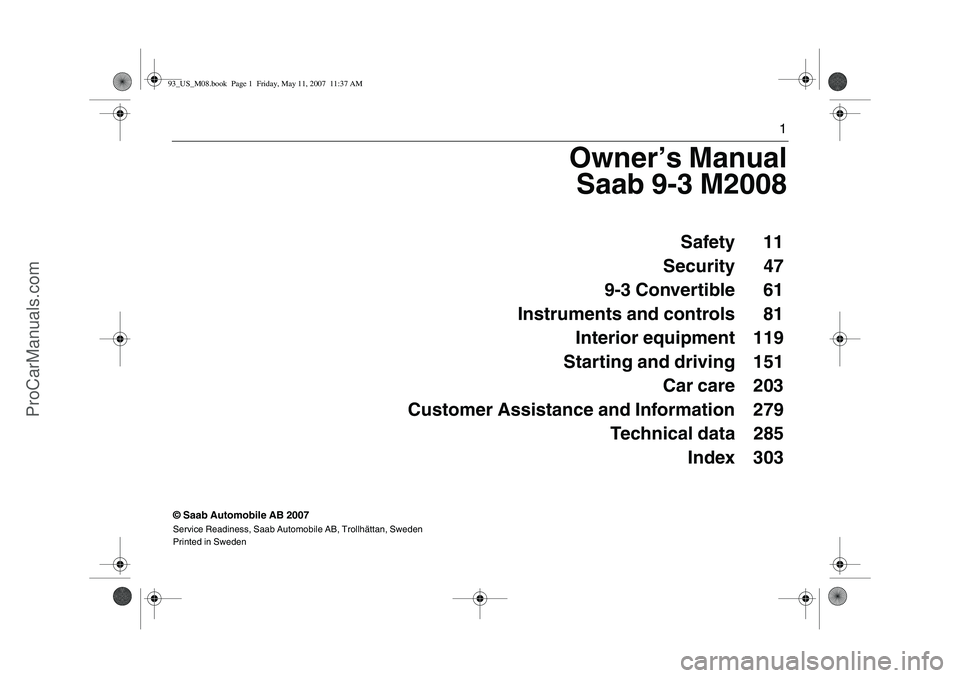
1
Owner’s Manual
Saab 9-3 M2008
© Saab Automobile AB 2007Service Readiness, Saab Automobile AB, Trollhättan, Sweden
Printed in Sweden
Safety 11
Security 47
9-3 Convertible 61
Instruments and controls 81
Interior equipment 119
Starting and driving 151
Car care 203
Customer Assistance and Information 279
Technical data 285
Index 303
93_US_M08.book Page 1 Friday, May 11, 2007 11:37 AM
ProCarManuals.com
Page 14 of 320
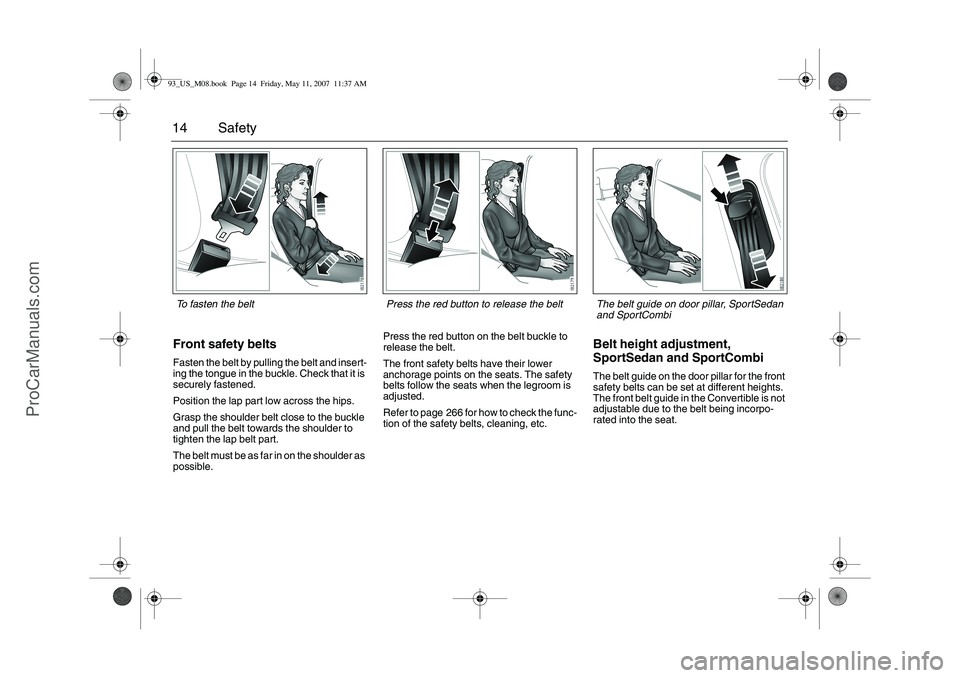
14 SafetyFront safety beltsFasten the belt by pulling the belt and insert-
ing the tongue in the buckle. Check that it is
securely fastened.
Position the lap part low across the hips.
Grasp the shoulder belt close to the buckle
and pull the belt towards the shoulder to
tighten the lap belt part.
The belt must be as far in on the shoulder as
possible.Press the red button on the belt buckle to
release the belt.
The front safety belts have their lower
anchorage points on the seats. The safety
belts follow the seats when the legroom is
adjusted.
Refer to page 266 for how to check the func-
tion of the safety belts, cleaning, etc.
Belt height adjustment,
SportSedan and SportCombiThe belt guide on the door pillar for the front
safety belts can be set at different heights.
The front belt guide in the Convertible is not
adjustable due to the belt being incorpo-
rated into the seat.
To fasten the belt Press the red button to release the belt
The belt guide on door pillar, SportSedan
and SportCombi
93_US_M08.book Page 14 Friday, May 11, 2007 11:37 AM
ProCarManuals.com
Page 17 of 320
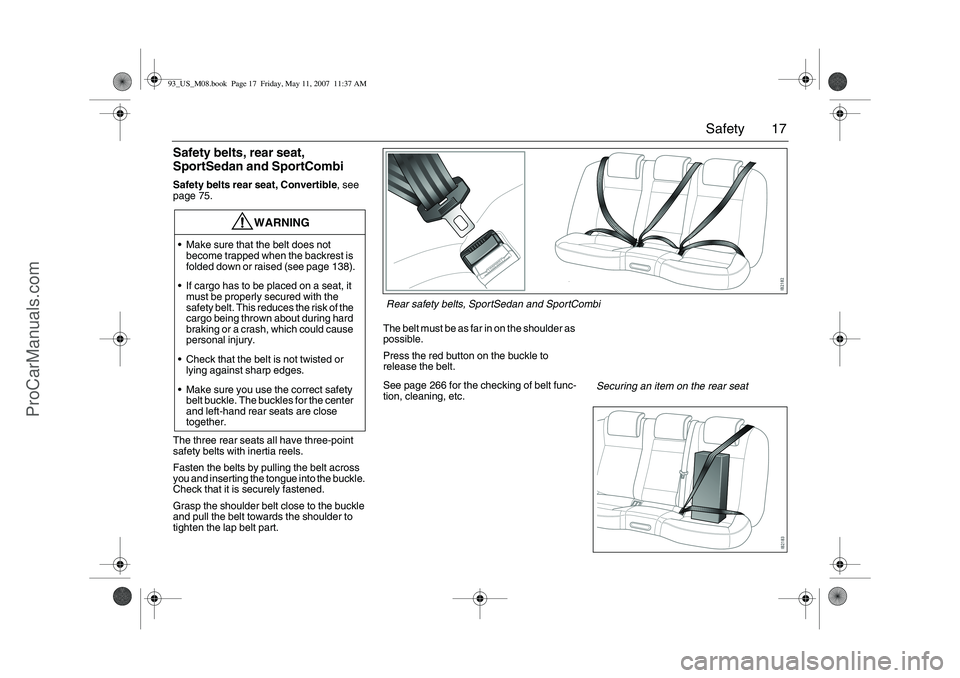
17 Safety
Safety belts, rear seat,
SportSedan and SportCombiSafety belts rear seat, Convertible, see
page 75.
The three rear seats all have three-point
safety belts with inertia reels.
Fasten the belts by pulling the belt across
you and inserting the tongue into the buckle.
Check that it is securely fastened.
Grasp the shoulder belt close to the buckle
and pull the belt towards the shoulder to
tighten the lap belt part.The belt must be as far in on the shoulder as
possible.
Press the red button on the buckle to
release the belt.
See page 266 for the checking of belt func-
tion, cleaning, etc.
WARNING
Make sure that the belt does not
become trapped when the backrest is
folded down or raised (see page 138).
If cargo has to be placed on a seat, it
must be properly secured with the
safety belt. This reduces the risk of the
cargo being thrown about during hard
braking or a crash, which could cause
personal injury.
Check that the belt is not twisted or
lying against sharp edges.
Make sure you use the correct safety
belt buckle. The buckles for the center
and left-hand rear seats are close
together.
Rear safety belts, SportSedan and SportCombi
Securing an item on the rear seat
93_US_M08.book Page 17 Friday, May 11, 2007 11:37 AM
ProCarManuals.com
Page 25 of 320
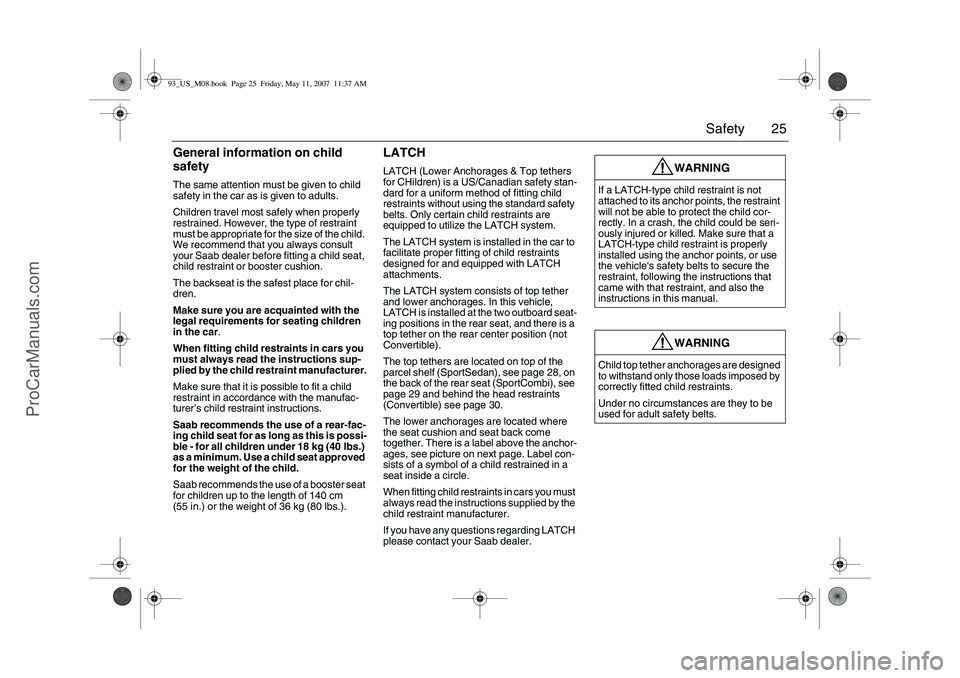
25 Safety
General information on child
safetyThe same attention must be given to child
safety in the car as is given to adults.
Children travel most safely when properly
restrained. However, the type of restraint
must be appropriate for the size of the child.
We recommend that you always consult
your Saab dealer before fitting a child seat,
child restraint or booster cushion.
The backseat is the safest place for chil-
dren.
Make sure you are acquainted with the
legal requirements for seating children
in the car.
When fitting child restraints in cars you
must always read the instructions sup-
plied by the child restraint manufacturer.
Make sure that it is possible to fit a child
restraint in accordance with the manufac-
turer’s child restraint instructions.
Saab recommends the use of a rear-fac-
ing child seat for as long as this is possi-
ble - for all children under 18 kg (40 lbs.)
as a minimum. Use a child seat approved
for the weight of the child.
Saab recommends the use of a booster seat
for children up to the length of 140 cm
(55 in.) or the weight of 36 kg (80 lbs.).
LATCHLATCH (Lower Anchorages & Top tethers
for CHildren) is a US/Canadian safety stan-
dard for a uniform method of fitting child
restraints without using the standard safety
belts. Only certain child restraints are
equipped to utilize the LATCH system.
The LATCH system is installed in the car to
facilitate proper fitting of child restraints
designed for and equipped with LATCH
attachments.
The LATCH system consists of top tether
and lower anchorages. In this vehicle,
LATCH is installed at the two outboard seat-
ing positions in the rear seat, and there is a
top tether on the rear center position (not
Convertible).
The top tethers are located on top of the
parcel shelf (SportSedan), see page 28, on
the back of the rear seat (SportCombi), see
page 29 and behind the head restraints
(Convertible) see page 30.
The lower anchorages are located where
the seat cushion and seat back come
together. There is a label above the anchor-
ages, see picture on next page. Label con-
sists of a symbol of a child restrained in a
seat inside a circle.
When fitting child restraints in cars you must
always read the instructions supplied by the
child restraint manufacturer.
If you have any questions regarding LATCH
please contact your Saab dealer.
WARNING
If a LATCH-type child restraint is not
attached to its anchor points, the restraint
will not be able to protect the child cor-
rectly. In a crash, the child could be seri-
ously injured or killed. Make sure that a
LATCH-type child restraint is properly
installed using the anchor points, or use
the vehicle's safety belts to secure the
restraint, following the instructions that
came with that restraint, and also the
instructions in this manual.
WARNING
Child top tether anchorages are designed
to withstand only those loads imposed by
correctly fitted child restraints.
Under no circumstances are they to be
used for adult safety belts.
93_US_M08.book Page 25 Friday, May 11, 2007 11:37 AM
ProCarManuals.com
Page 27 of 320
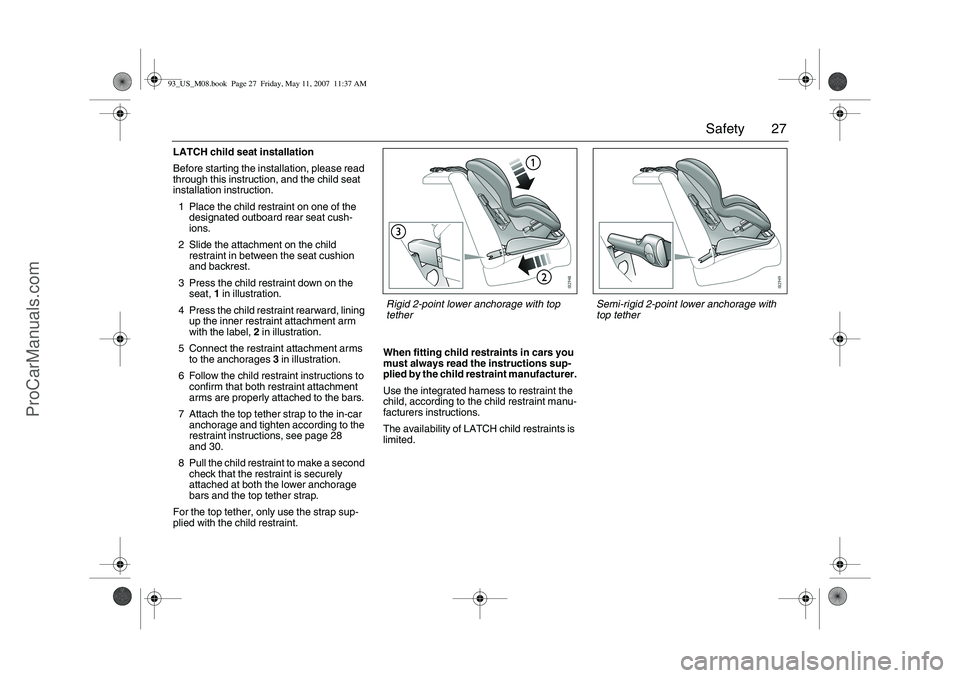
27 Safety
LATCH child seat installation
Before starting the installation, please read
through this instruction, and the child seat
installation instruction.
1 Place the child restraint on one of the
designated outboard rear seat cush-
ions.
2 Slide the attachment on the child
restraint in between the seat cushion
and backrest.
3 Press the child restraint down on the
seat, 1 in illustration.
4 Press the child restraint rearward, lining
up the inner restraint attachment arm
with the label, 2 in illustration.
5 Connect the restraint attachment arms
to the anchorages 3 in illustration.
6 Follow the child restraint instructions to
confirm that both restraint attachment
arms are properly attached to the bars.
7 Attach the top tether strap to the in-car
anchorage and tighten according to the
restraint instructions, see page 28
and 30.
8 Pull the child restraint to make a second
check that the restraint is securely
attached at both the lower anchorage
bars and the top tether strap.
For the top tether, only use the strap sup-
plied with the child restraint.When fitting child restraints in cars you
must always read the instructions sup-
plied by the child restraint manufacturer.
Use the integrated harness to restraint the
child, according to the child restraint manu-
facturers instructions.
The availability of LATCH child restraints is
limited.
Rigid 2-point lower anchorage with top
tetherSemi-rigid 2-point lower anchorage with
top tether
93_US_M08.book Page 27 Friday, May 11, 2007 11:37 AM
ProCarManuals.com
Page 28 of 320
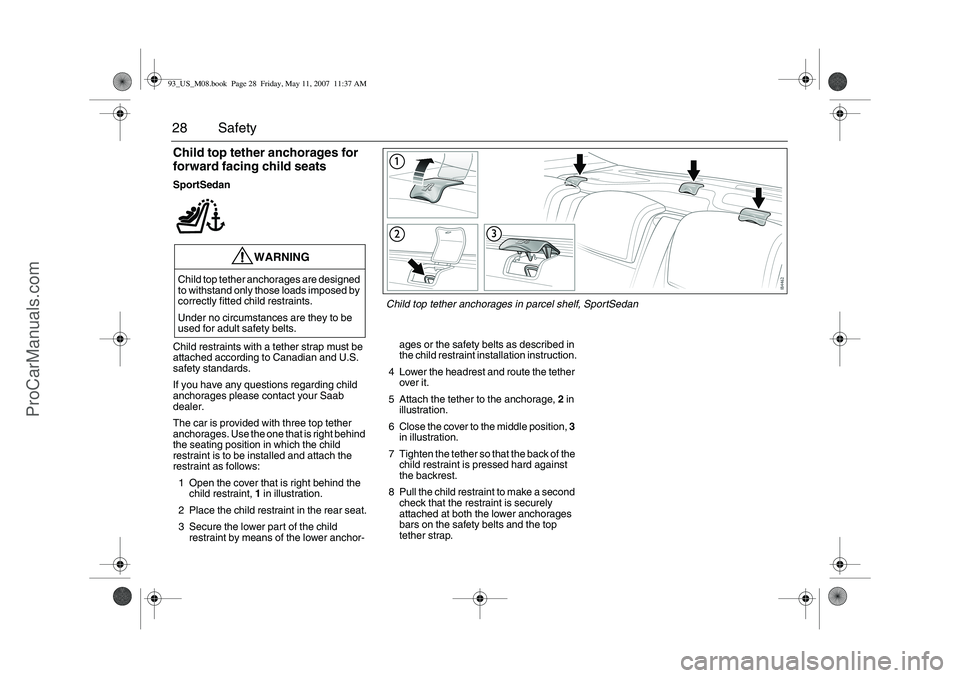
28 SafetyChild top tether anchorages for
forward facing child seatsSportSedan
Child restraints with a tether strap must be
attached according to Canadian and U.S.
safety standards.
If you have any questions regarding child
anchorages please contact your Saab
dealer.
The car is provided with three top tether
anchorages. Use the one that is right behind
the seating position in which the child
restraint is to be installed and attach the
restraint as follows:
1 Open the cover that is right behind the
child restraint, 1 in illustration.
2 Place the child restraint in the rear seat.
3 Secure the lower part of the child
restraint by means of the lower anchor-ages or the safety belts as described in
the child restraint installation instruction.
4 Lower the headrest and route the tether
over it.
5 Attach the tether to the anchorage, 2 in
illustration.
6 Close the cover to the middle position, 3
in illustration.
7 Tighten the tether so that the back of the
child restraint is pressed hard against
the backrest.
8 Pull the child restraint to make a second
check that the restraint is securely
attached at both the lower anchorages
bars on the safety belts and the top
tether strap.
WARNING
Child top tether anchorages are designed
to withstand only those loads imposed by
correctly fitted child restraints.
Under no circumstances are they to be
used for adult safety belts.
Child top tether anchorages in parcel shelf, SportSedan
93_US_M08.book Page 28 Friday, May 11, 2007 11:37 AM
ProCarManuals.com
Page 29 of 320
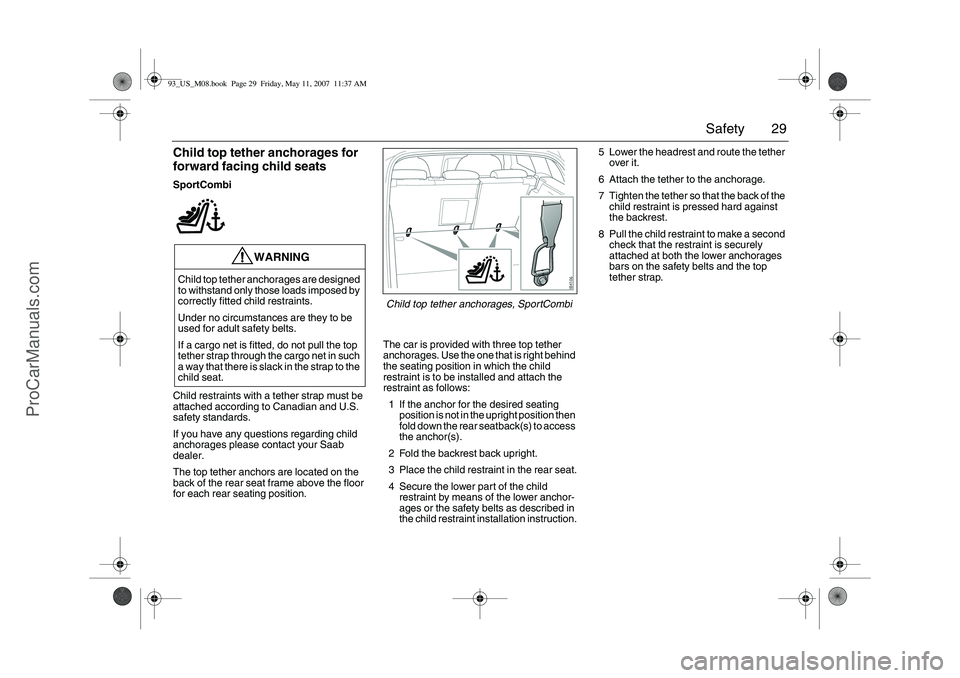
29 Safety
Child top tether anchorages for
forward facing child seatsSportCombi
Child restraints with a tether strap must be
attached according to Canadian and U.S.
safety standards.
If you have any questions regarding child
anchorages please contact your Saab
dealer.
The top tether anchors are located on the
back of the rear seat frame above the floor
for each rear seating position.The car is provided with three top tether
anchorages. Use the one that is right behind
the seating position in which the child
restraint is to be installed and attach the
restraint as follows:
1 If the anchor for the desired seating
position is not in the upright position then
fold down the rear seatback(s) to access
the anchor(s).
2 Fold the backrest back upright.
3 Place the child restraint in the rear seat.
4 Secure the lower part of the child
restraint by means of the lower anchor-
ages or the safety belts as described in
the child restraint installation instruction.5 Lower the headrest and route the tether
over it.
6 Attach the tether to the anchorage.
7 Tighten the tether so that the back of the
child restraint is pressed hard against
the backrest.
8 Pull the child restraint to make a second
check that the restraint is securely
attached at both the lower anchorages
bars on the safety belts and the top
tether strap.
WARNING
Child top tether anchorages are designed
to withstand only those loads imposed by
correctly fitted child restraints.
Under no circumstances are they to be
used for adult safety belts.
If a cargo net is fitted, do not pull the top
tether strap through the cargo net in such
a way that there is slack in the strap to the
child seat.
Child top tether anchorages, SportCombi
93_US_M08.book Page 29 Friday, May 11, 2007 11:37 AM
ProCarManuals.com
Page 30 of 320
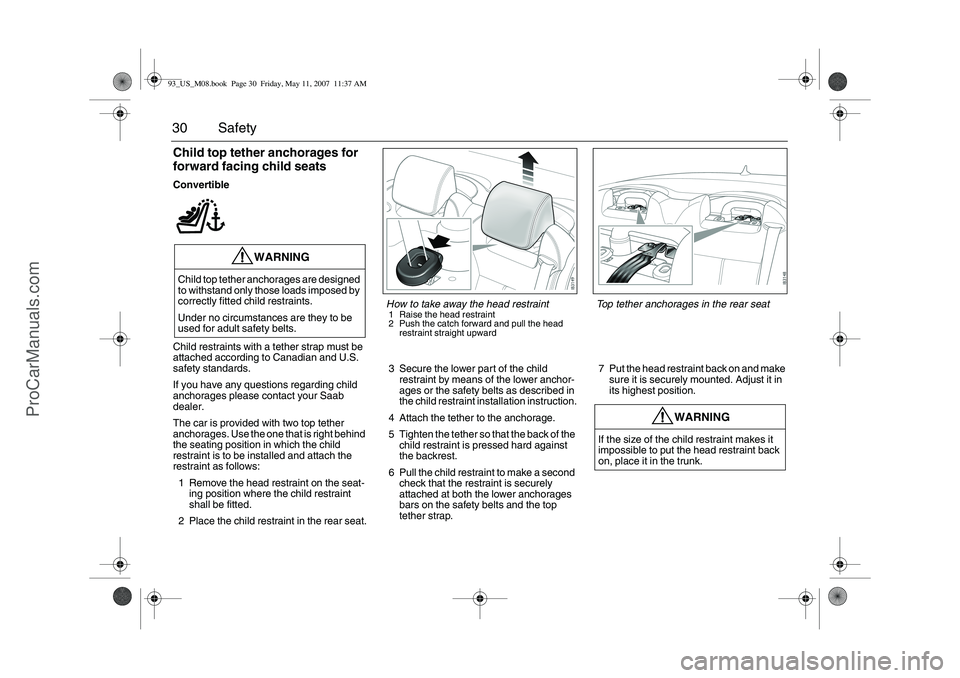
30 SafetyChild top tether anchorages for
forward facing child seatsConvertible
Child restraints with a tether strap must be
attached according to Canadian and U.S.
safety standards.
If you have any questions regarding child
anchorages please contact your Saab
dealer.
The car is provided with two top tether
anchorages. Use the one that is right behind
the seating position in which the child
restraint is to be installed and attach the
restraint as follows:
1 Remove the head restraint on the seat-
ing position where the child restraint
shall be fitted.
2 Place the child restraint in the rear seat.3 Secure the lower part of the child
restraint by means of the lower anchor-
ages or the safety belts as described in
the child restraint installation instruction.
4 Attach the tether to the anchorage.
5 Tighten the tether so that the back of the
child restraint is pressed hard against
the backrest.
6 Pull the child restraint to make a second
check that the restraint is securely
attached at both the lower anchorages
bars on the safety belts and the top
tether strap.7 Put the head restraint back on and make
sure it is securely mounted. Adjust it in
its highest position.
WARNING
Child top tether anchorages are designed
to withstand only those loads imposed by
correctly fitted child restraints.
Under no circumstances are they to be
used for adult safety belts.
WARNING
If the size of the child restraint makes it
impossible to put the head restraint back
on, place it in the trunk.
How to take away the head restraint1 Raise the head restraint
2 Push the catch forward and pull the head
restraint straight upward
Top tether anchorages in the rear seat
93_US_M08.book Page 30 Friday, May 11, 2007 11:37 AM
ProCarManuals.com
Page 31 of 320
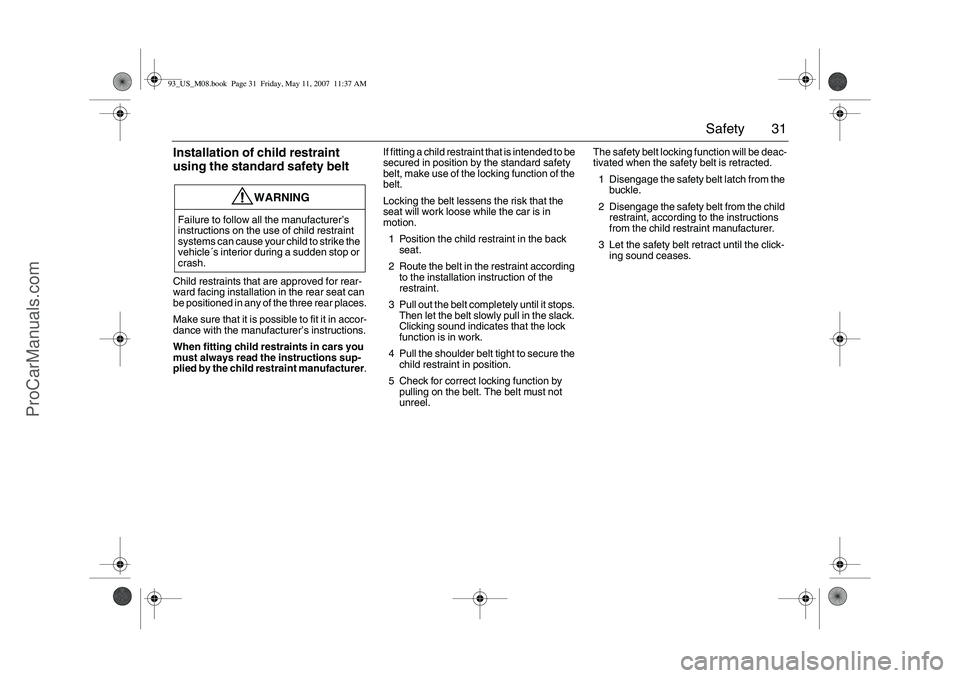
31 Safety
Installation of child restraint
using the standard safety beltChild restraints that are approved for rear-
ward facing installation in the rear seat can
be positioned in any of the three rear places.
Make sure that it is possible to fit it in accor-
dance with the manufacturer’s instructions.
When fitting child restraints in cars you
must always read the instructions sup-
plied by the child restraint manufacturer.If fitting a child restraint that is intended to be
secured in position by the standard safety
belt, make use of the locking function of the
belt.
Locking the belt lessens the risk that the
seat will work loose while the car is in
motion.
1 Position the child restraint in the back
seat.
2 Route the belt in the restraint according
to the installation instruction of the
restraint.
3 Pull out the belt completely until it stops.
Then let the belt slowly pull in the slack.
Clicking sound indicates that the lock
function is in work.
4 Pull the shoulder belt tight to secure the
child restraint in position.
5 Check for correct locking function by
pulling on the belt. The belt must not
unreel.The safety belt locking function will be deac-
tivated when the safety belt is retracted.
1 Disengage the safety belt latch from the
buckle.
2 Disengage the safety belt from the child
restraint, according to the instructions
from the child restraint manufacturer.
3 Let the safety belt retract until the click-
ing sound ceases.
WARNING
Failure to follow all the manufacturer’s
instructions on the use of child restraint
systems can cause your child to strike the
vehicle´s interior during a sudden stop or
crash.93_US_M08.book Page 31 Friday, May 11, 2007 11:37 AM
ProCarManuals.com
Page 36 of 320
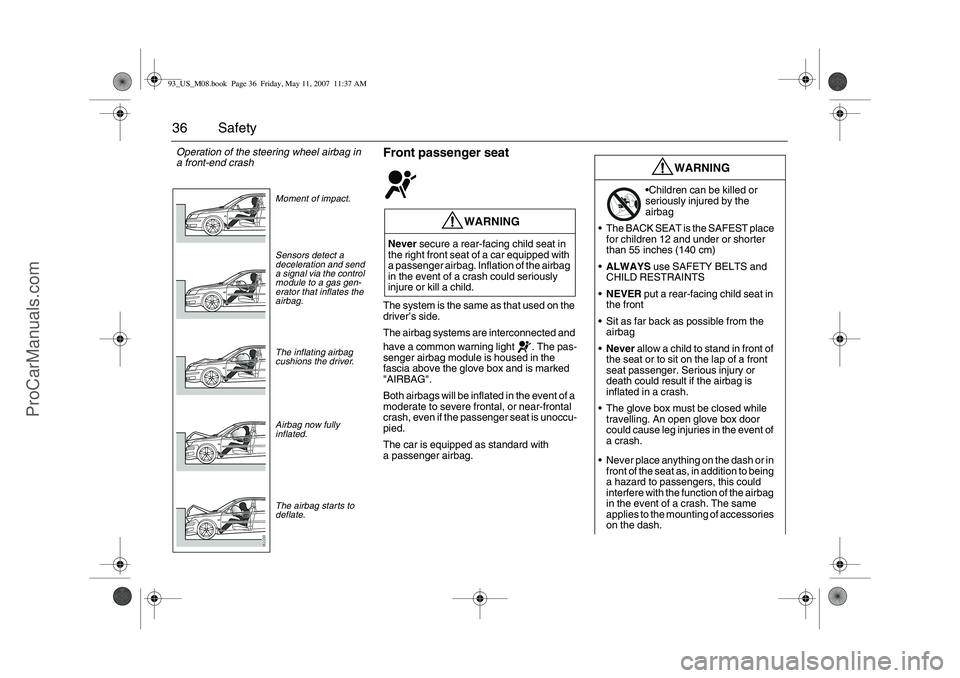
36 Safety
Front passenger seatThe system is the same as that used on the
driver’s side.
The airbag systems are interconnected and
have a common warning light . The pas-
senger airbag module is housed in the
fascia above the glove box and is marked
"AIRBAG".
Both airbags will be inflated in the event of a
moderate to severe frontal, or near-frontal
crash, even if the passenger seat is unoccu-
pied.
The car is equipped as standard with
a passenger airbag.
WARNING
Never secure a rear-facing child seat in
the right front seat of a car equipped with
a passenger airbag. Inflation of the airbag
in the event of a crash could seriously
injure or kill a child.
WARNING
Children can be killed or
seriously injured by the
airbag
The BACK SEAT is the SAFEST place
for children 12 and under or shorter
than 55 inches (140 cm)
ALWAYS use SAFETY BELTS and
CHILD RESTRAINTS
NEVER put a rear-facing child seat in
the front
Sit as far back as possible from the
airbag
Never allow a child to stand in front of
the seat or to sit on the lap of a front
seat passenger. Serious injury or
death could result if the airbag is
inflated in a crash.
The glove box must be closed while
travelling. An open glove box door
could cause leg injuries in the event of
a crash.
Never place anything on the dash or in
front of the seat as, in addition to being
a hazard to passengers, this could
interfere with the function of the airbag
in the event of a crash. The same
applies to the mounting of accessories
on the dash.
Operation of the steering wheel airbag in
a front-end crash
Moment of impact.
Sensors detect a
deceleration and send
a signal via the control
module to a gas gen-
erator that inflates the
airbag.
The inflating airbag
cushions the driver.
Airbag now fully
inflated.
The airbag starts to
deflate.
93_US_M08.book Page 36 Friday, May 11, 2007 11:37 AM
ProCarManuals.com